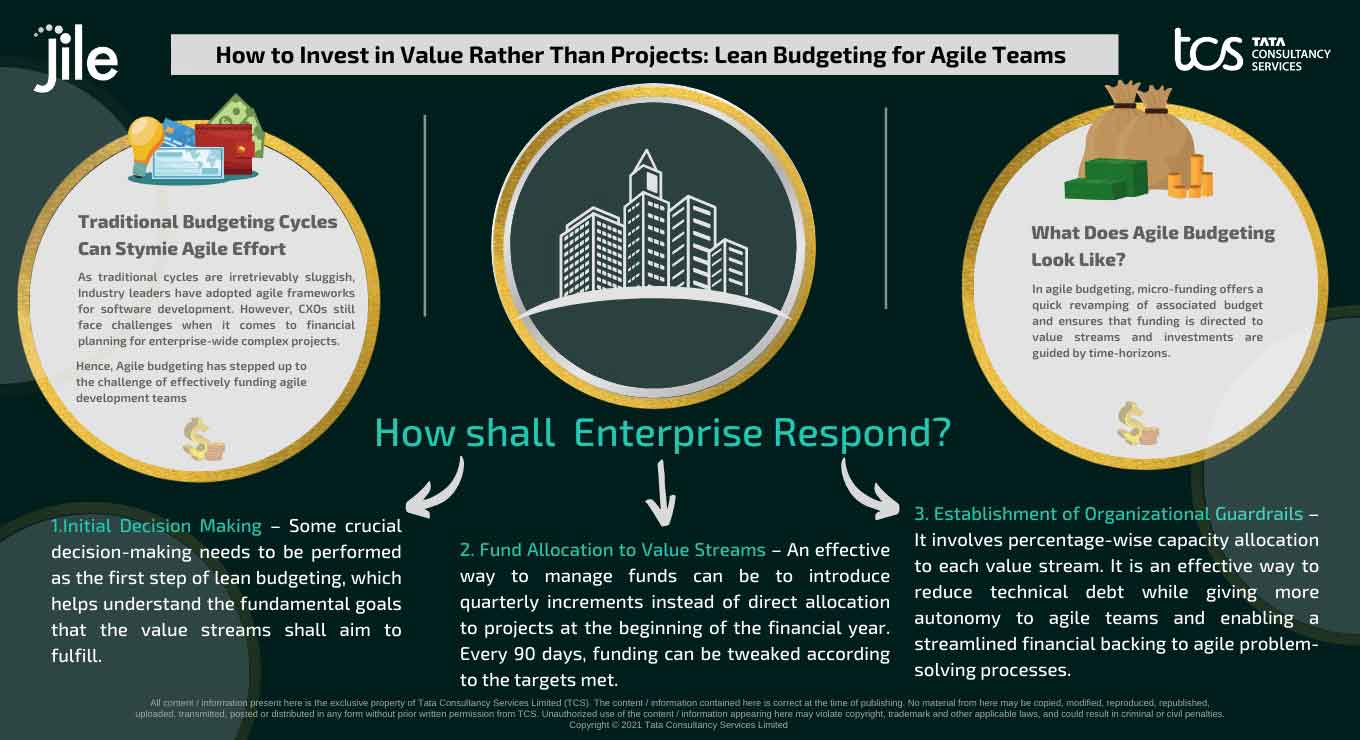How to Invest in Value Rather Than Projects: Lean Budgeting for Agile Teams

CIOs are increasingly turning to flexible models, such as agile software development for IT, to swiftly deliver outcomes and innovation. But, traditional planning cycles can seriously hinder agile processes and consequently the company's strategic efforts. Digital solutions have helped leaders incorporate the evolving requirements of agile teams into their financial models by providing analytics, project management, and end-to-end financial planning. Organizations can effectively plan their finances by implementing lean budgeting methodologies alongside digital solutions for agile software delivery.
Leaders can digitize their enterprise only after streamlining essential services that make up the core of their business functions. Many digital optimization efforts are implemented expecting it to be the short road for cost efficiency. But, liabilities stock up fast when a new development doesn't fly. By the time the plans and funds for a rework are sanctioned, a competitor has achieved seamless digital management and is developing products that do fly. And, costs of regrouping or recruiting can be heavy. COVID-19 has exponentially increased the risks of functioning with such a model. Where most enterprises are upgrading their project portfolio management with solutions based on automation, cloud and IoT, the successful ones are first implementing operational changes.
Traditional Budgeting Cycles Can Stymie Agile Efforts
Traditionally, companies plan and allocate funds for projects annually. But, projects may pan out in a manner entirely different from their original charter. Executives recognize this, and include contingency costs in their requests for funding. In report cycles, the KPIs often exclude the growth metrics that became more relevant as the project progressed.
Traditional zero-based and annual project funding have been the corporate norm. Compliance regulations and investor expectations inevitably keep it that way. However, traditional cycles that determine budgets for dynamic projects, especially in feature-driven software delivery, have proved to be irretrievably sluggish. Industry leaders have adapted agile frameworks for software development at the team and team-of-teams level. But, CXOs still face challenges when it comes to financial planning for enterprise-wide complex projects- where objectives are tweaked as it goes. While annual planning remains, budgeting cycles are changing to accommodate the rhythm at which these projects function. Companies are adopting flexible budgets and progressive fund allocation methods while never losing sight of OKRs, using a range of tools. Agile budgeting has stepped up to the challenge of effectively funding agile development teams.
What Does Agile Budgeting Look Like?
In agile budgeting, micro-funding of developments with a broad strategic objective replaces project-based allocation. Feedback loops in product-focused agile development are driven by demonstrable KPIs. It is achieved with monthly or quarterly reviews of the demand for and revenue from the new developments. This allows for a quick revamp of associated budget plans when something is or isn't working out and ensures that funding is directed to value streams more than 'projects' and that investments are guided by time-horizons.
Budgeting for agile software development teams isn't all about tackling an obstacle course. Radical cost transparency is a potent trust exercise between the employees and the company. When members work in cross-functional teams focused on long-term value streams with changing blocs of deliverables and results, they become experts. It leads to value addition in terms of upskilling, efficient team processes, holistic incentives, and transparent business outcomes.
How Do Enterprises Respond?
In deciding budgets for agile software development systems with agile planning, the first step is to comb out value streams from the product or solution framework and identify the decisions you might have to make- should we develop this feature or not? By when can I expect the results? What would be the next steps? This initial decision-making comprises the fundamental goals that your value streams will aim to fulfil. Detailed and abstract decisions require a cost estimation while strategic decisions require a budget. Lean budgeting is up for the task of funding variable solutions.
Digital technologies like AI, machine learning, and integrated systems are enabling data-driven decisions in value stream identification, value stream mapping, workforce management and financial planning. An agile planning and management tool often provides a single platform to manage value streams at every stage - ideation, planning, development, testing, and deployment. At the planning stage, it can help product portfolio management by identifying value streams before strategic initiatives are implemented. Because this process is cyclical for agile teams, these platforms keep up by providing real-time progress metrics. This helps visualize roadmaps for multiple products in relation to business strategies and objectives, as well as track their development and measure progress.
The next step is to allocate funds transparently to value streams. This keeps all stakeholders on the same page about the anticipated spend, regardless of the specific developments. A potential solution is to introduce quarterly increments instead of direct allocation to projects in the beginning of the financial year. Every 90 days, funding can be tweaked according to the targets being met. KPIs, with the help of data analysis of metric fulfilment, are mapped digitally, continuously. The organized data from value stream mapping can then be studied by business enablers and stakeholders. The right solutions for agile delivery enable the enterprise to accomplish these milestones through inbuilt, well-defined budgeting and analytics capabilities that help teams stay on track without sabotaging costs.
The third step is to establish organizational guardrails, such as capacity allocation. For example, assigning a percentage of capacity to each value stream. It is an effective way to reduce technical debt while giving more autonomy to agile teams. This also enables a streamlined and ready financial backing to agile problem-solving processes.
Conclusion
When it comes to product portfolio management, with lean budgeting, multifunctional teams have a complete roadmap of multiple product developments as well as the freedom to invest in appropriate initiatives. When product managers and developers have homogenous access to the vision, tasks, backlogs and progress, the risk of cost overruns in IT projects is seriously minimized. While this is easy to achieve in small teams, scaling such a framework to your entire enterprise is a much bigger task. Enterprise agile frameworks such as SAFe, LeSS Huge and DAD make it easier. The scaling must be supported with changes in financial planning.
For budget friendly agile project magement software, get in touch with Jile experts
Thanks for subscribing to our latest blogs, thought leadership and other product updates!
Read our Privacy Notice to know more. You can opt-out of all communications anytime.

